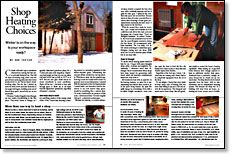Shop Heating Choices
Winter is on the way. Is your workspace ready?
Synopsis: The day Ken Textor picked up some #6 screws in his unheated shop and they stuck to his ungloved fingers, he began investigating heating options seriously. He decided to heat an area that would allow him to glue, finish, and do intricate woodwork, leading him to the first major decision of heating his shop: how much of it do you heat? He chose to use solid-foam insulation and evaluated safety, economy, and simplicity in choosing a heat source. He settled on propane and explains why. A side article highlights the heating choices four other woodworkers chose.
Clouds of breath vapor sometimes obscured my cutting line but never seriously bothered me. Nor did 20 years of wearing long Johns and two pair of wool socks significantly slow down productivity in my Maine-based woodworking shop. But the day I picked up some #6 steel screws and they stuck fast to my ungloved fingers, building some sort of heated shop space moved way up on my priority list.
Of course, Yankee frugality was what got me into tundra woodworking in the first place. That wasn’t about to change, so I quickly dismissed grandiose plans for a T-shirt-and-jeans-style megashop. Experience had taught me that you can cut, plane and sand wood just as well at 20°F as at 60°F. But you can’t glue, finish and do intricate woodwork in arctic conditions. Right off the bat, I decided to heat only enough space to allow me to do these warmth-dependent operations, regardless of January’s nastiness.
How much shop to heat?
An unwilling student of the energy crises of the 1970s, I knew that choosing a heating source is a secondary question in the winter-warmth game. Minimizing the amount of heat needed was my top priority. With that in mind, the first question was, how big an area do I really need to heat? To generate some actual dimensions, I started with the assumption that the largest project I would build, and therefore need to maneuver in my new heated shop space, would be something like a custom door. To work comfortably on projects of this scale, I determined that I’d need roughly 160 sq. ft., a relatively modest space.
Because my existing, to-remain-unheated shop already occupied the best solar area, with a southerly exposure and lots of glass for solar gain, I opted for the next best solar space: the second floor. Because warm air rises, of course, a second-floor location takes advantage of solar gains generated below and avoids the lion’s share of dust created on the first floor.
From Fine Woodworking #133
For the full article, download the PDF below:




















Log in or create an account to post a comment.
Sign up Log in